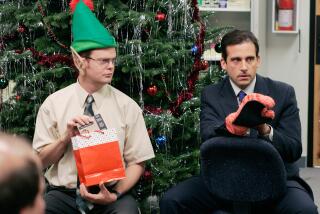Moderation Should Be Prevailing Theme at Office Holiday Soirees
- Share via
When business people think about the holidays, many things come to mind, such as temporary help to handle extra work, the end of the year and distribution of employee bonuses. But December also often means valued employees may be on the road--or on the job--after consuming large amounts of alcohol.
The Los Angeles-based Century Council, a national, not-for-profit organization dedicated to fighting alcohol abuse, was founded in 1991 by the beverage alcohol industry. We have focused on two areas: drunk driving and underage drinking. We know that office parties and other celebrations are an appropriate part of the season, but we also know that caution must be taken to ensure that the effects of these celebrations don’t continue long after the party ends. And we know that your concern for your employees does not end when they walk out the door at the end of the day.
Over the last decade, designated drivers, safe-ride-home programs and other tools to fight drunk driving have become holiday fixtures. The result of such efforts has been a significant, steady decline in annual alcohol-related fatalities in the United States--from 23,758 nationwide in 1984 to 16,589 in 1994, a 30% drop. That’s a lot of progress. Still, in Los Angeles County alone last year, 11,870 people were injured in police-reported alcohol-involved crashes.
But drunk driving is only part of the holiday picture. Most people who drink do so responsibly and without negative consequences. Still, employers need to know that employees who drink heavily, whether at office parties or on their own time, may still be legally drunk when they show up for work the next day.
Consider these facts:
* In California, the legal definition of “drunk” is a blood alcohol content (BAC) of 0.08%.
* The legal limit for commercial drivers is 0.04%.
* The average BAC of drunk drivers arrested in California is 0.15%, nearly twice the legal limit.
* Most people’s bodies take about one hour to process the alcohol from one drink.
This means that a 170-pound male employee who goes to bed at 3 a.m. with a BAC of 0.17% will still have a BAC of about 0.10%, well over the legal limit, when he reports to work at 8 a.m.
He could even be cited for drunk driving if he reports at 9 a.m. because his BAC will still be more than 0.08% (because women’s bodies contain a lower percentage of muscle tissue, women usually reach each BAC level faster than men).
In the meantime, your employees may be operating machinery, driving company vehicles or meeting with clients. Perhaps they are manufacturing delicate electronic equipment or manipulating complex data in your computer system. If these tasks are affected as a result of last night’s party, that raises serious issues in areas such as workers’ compensation, insurance, health-care costs, quality control and liability--all bad for the bottom line.
If your company is hosting a holiday party, you can protect your company and your employees in the way you structure the party. Some suggestions:
* Encourage employees to choose and to serve as designated drivers.
* Provide the phone numbers of local cab companies to provide alternative rides. Make sure employees can get access to their cars the next day if they leave them overnight.
* Serve plenty of food to slow the absorption of alcohol into the blood. But avoid salty snacks; thirsty people drink more.
* Make sure that nonalcoholic drinks are available.
* Close the bar an hour before the party is scheduled to end. This gives people’s bodies time to process their last drink before they drive home.
* Serve another round of food after the bar closes. This will help delay people’s getting in their cars, and slow down the absorption of that last drink.
With the great progress that has been made in reducing alcohol-related traffic fatalities, many people ignore the wide range of consequences that fall short of being killed. Before the holiday season gets into full swing, you will be doing your employees and your business a great service if you remind employees of the consequences of a drunk driving arrest.
Few people realize that in California, a Breathalyzer test showing a BAC of 0.08% or more, or a refusal to take the test, results in an automatic license suspension--four months on a first offense and two years on a repeat offense.
Then come potential jail time, fines, legal and insurance costs mounting into the thousands of dollars as well as possible consequences at work, ranging from a reprimand to possible loss of employment, if the arrest places the employee in violation of a company policy on alcohol use. The chances of being stopped for drunk driving are also much higher than usual at this time of year, with the increased use of sobriety checkpoints.
Even if your employees are not celebrating at a company party, their use of alcohol can affect their work--and your business. This is especially important if any of your employees drives as part of his or her job, either in his or her own or company vehicles.
The financial cost of an alcohol-related crash is fairly easy to quantify; the financial impact of impaired job performance is harder to quantify. Both are vitally important.
More to Read
Inside the business of entertainment
The Wide Shot brings you news, analysis and insights on everything from streaming wars to production — and what it all means for the future.
You may occasionally receive promotional content from the Los Angeles Times.










